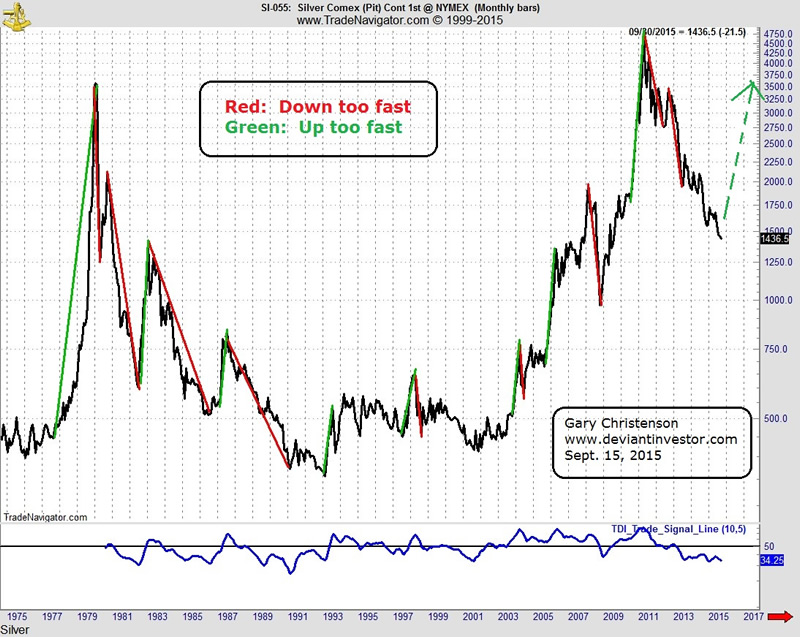Silver: Victim of Motive, Means, and Opportunity
Commodities / Gold and Silver 2015 Sep 25, 2015 - 07:43 PM GMTBy: DeviantInvestor
 Silver gets little respect, but that is sensible in a world dominated by paper assets and pretend values. Similar to a murder investigation, let’s examine the motive, means and opportunity used to “manage” silver prices.
Silver gets little respect, but that is sensible in a world dominated by paper assets and pretend values. Similar to a murder investigation, let’s examine the motive, means and opportunity used to “manage” silver prices.
MOTIVE: The price of silver is important to industrial users, since there are thousands of uses for silver, many of which have no alternative except silver. If the price of silver rises too rapidly, people notice. Worse, a price rally in silver probably will spread to the gold market, which is watched globally by banks, institutions, and people. A rapidly rising price of gold informs the world that central banks are “printing” to excess, governments are creating too much debt, and the financial elite are mismanaging by “skimming” too much from the global economies. A rising gold price is worrisome to many.
Obviously, the price of gold and silver must be “managed” so that confidence in paper currencies, central banks, and governments is maintained. We know that central banks intentionally devalue their currencies, but they want the process to remain slow, deliberate, and largely unseen. Hence, central banks, governments, and the financial elite have a strong motive for managing the price of silver and gold.
MEANS: The annual value of all silver mine output is perhaps $15 Billion. By contrast, the US government increases its official debt by that much in less than a week. Comparatively speaking, the silver market is tiny. Therefore the means to levitate or crush the market is both easily available and clear. A few $Billion can drive COMEX prices far higher or lower quickly, especially if “the managers” use futures contracts during illiquid times in the overnight market. Andy Hoffman has extensively documented this process.
OPPORTUNITY: The futures markets are open 250+ days per year. The silver market is also open but illiquid about the same number of nights per year. That alone provides ample opportunity for price suppression or levitation as needed by the financial elite. Additionally silver is traded in London and can be “trashed” or hyped in the media. The opportunity to “manage” prices is clearly available.
HIGHER AND LOWER:
Management is not limited to pushing prices lower. Look at the 40 year log scale chart of silver. Clearly prices increased substantially between 2001 ($4.01) and April 2011 (over $48). Subsequent to that large rally silver prices crashed below $15 in July of this year.

COMMENTS:
- Silver prices spend most of the time moving little and then, for a short time, move too far and too fast, both up and down.
- The moves up are more fun for those of us who understand the value of silver, the counter-party risk of most paper assets, and the dangers of debt based fiat currencies. But down moves are opportunities.
- Crashes occur: Japanese real estate, silver after 1980, the NASDAQ in 2000, real estate in 2008, Enron stock, and a few political reputations. Managed crashes can be highly profitable for the financial elite and costly to the bottom 95% of the public. Expect more crashes, more often.
- In my opinion, one of the best ways to discourage silver investors is to run the price up, hype it all the way, massively sell futures short near the top, “encourage” the COMEX to increase margins, and ride the price collapse down. Retail investors typically come into the market late, ride it up, feel euphoric until the crash, get out too late, and then, after huge losses, swear they will NEVER look at silver again. This process works well for the banks – such as in 1980, 1987, 2008 and 2011. If the rally and crash happens every decade or so, a new group of retail investors can be roped in, fleeced, and discouraged regarding silver.
- Silver prices are approximately triple what they were a decade ago, but are down 70% from their 2011 highs. Sentiment is bearish after 52 months of declining prices.
- If silver had slowly risen from under $10 in 2008 to $15 today, nobody would be excited, but the pervading negative sentiment would probably be absent. The too far, too fast rally and subsequent crash succeeded in crushing sentiment. Not coincidentally since 2011, the dollar and bonds have rallied, and the S&P reached all-time highs. Real assets down, paper assets up! There is method to this madness.
But madness it is – paper assets based on fiat currencies crash every seven years or so – and they are due for another adjustment lower to match their underlying value. Similarly, silver is due for an adjustment much higher to regain its underlying value.
Gary Christenson
GE Christenson aka Deviant Investor If you would like to be updated on new blog posts, please subscribe to my RSS Feed or e-mail
© 2015 Copyright Deviant Investor - All Rights Reserved Disclaimer: The above is a matter of opinion provided for general information purposes only and is not intended as investment advice. Information and analysis above are derived from sources and utilising methods believed to be reliable, but we cannot accept responsibility for any losses you may incur as a result of this analysis. Individuals should consult with their personal financial advisors.
Deviant Investor Archive |
© 2005-2022 http://www.MarketOracle.co.uk - The Market Oracle is a FREE Daily Financial Markets Analysis & Forecasting online publication.



